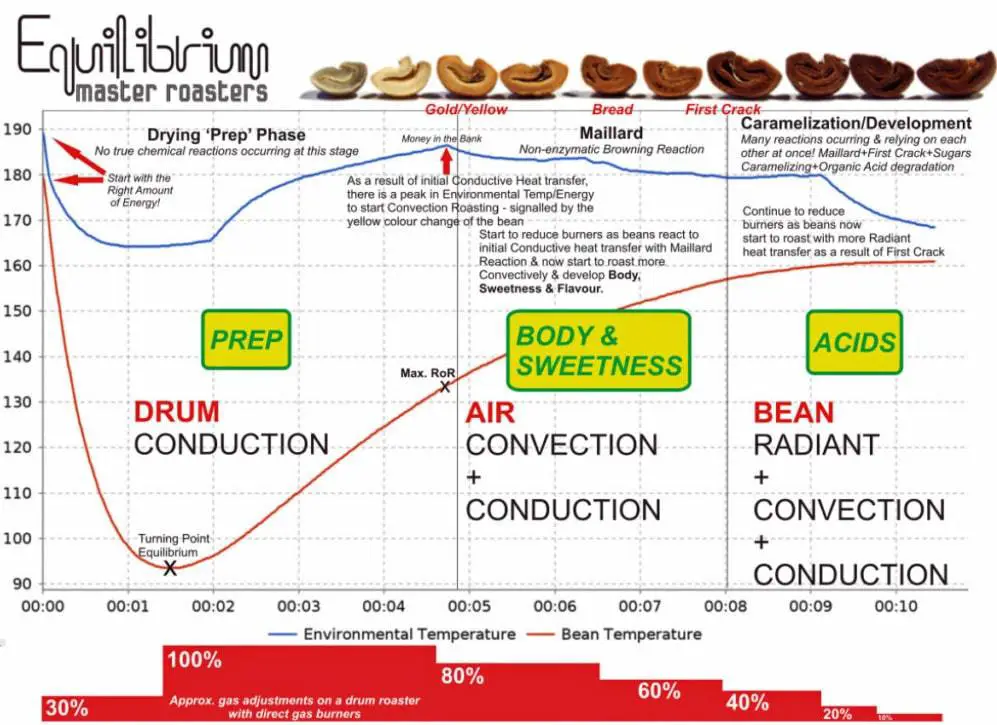Navigating through the ocean of coffee roasting, I’ve come to see myself as the captain of a ship, steering through the waves of heat and time to discover the treasure of perfect flavor. It’s a craft that demands precision and passion, where I find myself constantly adjusting the sails—my roasters—to harness the full potential of the beans.
I’ve learned that each green bean carries a universe of possibilities, and it’s my task to unlock them. As I’ve delved deeper into the world of roasting, I’ve come to appreciate the delicate balance of art and science that defines this practice.
In this coffee roasting guide I share my journey of honing this craft, exploring the nuances of roast profiles and the subtle artistry that turns a humble bean into a symphony of taste. Join me as I unfold the layers of mastery in the art of coffee roasting.
Continue Reading to Understand These Key Points:
- The coffee roasting process is a critical step in the value chain of coffee production.
- The flavor profile of coffee is directly related to the roasting profile.
- Different coffee roasts are categorized based on their color.
- Understanding the temperature chart is crucial for achieving the desired flavor profile.
Understanding Coffee Roast Levels
Understanding coffee roast levels is crucial to a roaster’s ability to craft a bean’s ultimate flavor profile. Each roast, whether light or dark, significantly influences the symphony of flavors that dance upon the palate.
Light roasts, with their subtle, bright acidity, offer a glimpse into the bean’s inherent character, a reflection of its origin’s soil and sun. On the other hand, dark roasts speak a bolder language; they carry a robust, caramelized sweetness, eclipsing subtler notes with their pronounced intensity.
The impact of roast levels on flavor can’t be overstated. It’s a transformative journey from green, grassy notes to a rich, full-bodied experience. As a seasoned roaster, I’ve learned that the secret lies in balancing the heat, timing, and bean’s potential, creating a masterpiece in every cup.
Exploring Roasting Techniques
Building on a roaster’s knowledge of roast levels, I’ll delve into the diverse techniques that turn green beans into aromatic masterpieces. Passionate about the alchemy of flavor, I understand that each batch reflects the heart of its origin. Coffee bean origins play a pivotal role in the process – the unique characteristics of each region must align with the chosen roasting method to maximize potential.
My coffee roasting equipment is an extension of my craft, allowing for precision and consistency.
Here are the key techniques I employ:
- Drum Roasting: A traditional method that offers remarkable control over each batch.
- Air Roasting: Provides a cleaner taste by using hot air to ensure even heat distribution.
- Pan Roasting: An artful, hands-on approach that connects me to the roots of roasting.
Each technique demands my utmost attention and skill, ensuring that every cup tells a story.
Analyzing Roasting Temperature Charts
I often consult a roasting temperature chart to ensure my beans reach the perfect level of roast, balancing flavor and aroma with precision. When I’m exploring flavor profiles, this chart becomes my roadmap, guiding me through the intricate dance of heat and time.
It’s not just about hitting the right temperatures; it’s about understanding how each degree influences the bean’s character, revealing the subtle notes hidden within.
Achieving consistency in roasting is an art. The temperature chart is my canvas, and each roast is a meticulous stroke of craftsmanship. With every batch, I refine my technique, ensuring the chart’s wisdom is translated into the beans’ essence.
The chart tracks the temperature curve as the beans are roasted, capturing the critical phases such as drying, Maillard reactions, first crack, and if applicable, second crack. Each of these stages corresponds to specific chemical changes within the coffee beans, impacting their ultimate flavor, aroma, and body.
For instance, the drying phase involves removing moisture from the beans, the Maillard reactions contribute to flavor and color development, the first crack indicates the onset of bean expansion and the development of a lighter roast, while the second crack leads to a darker roast with more intense flavors.

Credit: Equilibrium Master Roasters
A typical coffee roast profile chart will have time on the horizontal axis and temperature on the vertical axis. As the roast progresses, the temperature rises in a curve that should ideally be smooth without any sudden spikes or drops, which could adversely affect the roast quality.
The roaster will mark down when specific events occur, such as when the beans reach a certain color or when the first crack happens. By logging these events, the roaster can replicate successful roasts or adjust the profile to experiment with different roasting outcomes.
In more advanced setups, roasting profile charts can be integrated into software that controls and automates the roasting machines. This allows for even more precision, as the software can make real-time adjustments to the temperature and airflow to follow the desired profile.
These charts often come with additional features like rate of rise (RoR), which is the speed at which the temperature increases. RoR is a critical element as it can affect the development of flavors and the consistency of the roast.
This is where science meets sensibility, and I relish the pursuit of the elusive perfect roast.
Navigating Roast Profiles

Exploring roast profiles is integral to my journey as a coffee roaster, as each level imparts a distinct flavor and aroma to the beans. I’ve found that mastering roast development is key to unlocking those rich flavor variations that truly captivate the palate.
Here’s what I focus on:
- Understanding the Bean: Each variety responds differently to heat, and I adjust my approach accordingly.
- Monitoring the Process: Careful observation ensures I catch the subtle changes indicating the transition between roast stages.
- Taste Testing: Regular sampling of different profiles guides my adjustments and hones my craft.
I pour my heart into every batch, aiming for that perfect balance where each sip tells the story of its meticulous roasting journey.
Emphasizing Education and Experimentation
Delving into the nuances of roast development, I’ve learned that education and experimentation are indispensable for mastering the art of coffee roasting. The education benefits are multifold, equipping me with a deeper understanding of the complex chemistry behind each bean’s transformation.
Through courses and mentorship, I’ve embraced the science and artistry that dictate the subtleties of flavor and aroma.
Adopting experimental approaches has been equally vital. I’m not afraid to tweak temperature curves or extend development times to tease out unique profiles from each batch. With each experiment, I’ve found that the knowledge gained is as rich as the coffee I roast.
It’s a journey of endless learning, where each batch is a lesson and each bean an opportunity to refine my craft.
Final Thoughts
In my quest for perfection, I’ve scorched more beans than a novice at a campfire. Yet, it’s through these smoky missteps that I’ve truly honed my craft.
Each charred batch, a bittersweet lesson learned. Who knew that the secret to unlocking the symphony of flavors in a humble bean lay in the very mistakes I was brewing?
In roasting, as in life, the richest notes often emerge from the fires of our greatest blunders.


Love the part about roasting techniques. Always wondered how they bring out those flavors. Do you think home roasting can compare?
Fascinating insights into the alchemy of coffee roasting. It’s intriguing how historical practices have evolved into modern techniques. Thanks for sharing, Emma.
hmm im curious about the roast profiles. like, do different countries have specific profiles they prefer? or is it more about the bean? always looking to up my coffee game lol
Great question, JennyBean. Coffee preferences can be quite regional but there’s also a lot depending on the bean itself and the roasting style preferred by the coffee culture in that area.
Nice article. I didn’t know roasting coffee was so complex.
I agree with most points, but don’t you think the roast level is more crucial than the method? It’s like, the roast sets the stage for flavor, while technique is more about refining it.
So, by ‘scorched more beans than a novice at a campfire’, you’re saying there’s hope for all of us wannabe roasters? Inspiring…and here I thought my burnt beans were a sign to give up.
Awesome read! Roasting’s an art and love how you broke it down for us. Gonna share this with my crew!